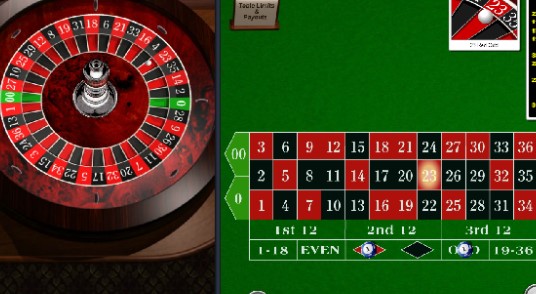The arrival of the Internet, casinos have had the opportunity to move to digital platforms, adding a number of users willing to experience from the comfort of their homes at any time. All the variants of the games, call poker, dice, baccarat, blackjack or slots, maintain their essence, and some players hardly notice the different dynamics.
With the roulettes, however, the design for the web has a feature that will never be shared with those built for online casinos: the bias. This flaw, which occasionally alters the operation of this game, does not occur or ever occur in online betting rooms.
To begin with, a skewed roulette is a normal roulette wheel that, due to details in its construction, wear or chance, turns the turns into a pattern that always throws the same numbers, or surpasses certain shots that come out.
Many players are not able to notice this feature until it becomes extremely evident. For this reason, when they alert this flaw, they begin to write down on a card the numbers that coincide systematically.
When the bias in roulettes happens by chance, it is very difficult to repair them. Fortunately, most of the reports that reputable casinos receive about biased roulettes are due to mechanical errors. Identifying them is the key to solving the problem and the first step that must be taken.
So, these are the signals that can be used to know if a roulette is skewed:
Wade of the wheel
As a mechanical system that turns, naturally, the roulettes are constituted by a wheel. The objective is to remain firm and allow the upper part to rotate on its own axis until it stops. When it works correctly, the turns are usually clean regardless of the force or speed with which the players act.
However, the wheels may slip out of its central core and cause a constant wobble that hits the roulette wheel. To detect this bias, it is enough to stop at a point where the wheel is clearly reflected and observe if there is an oscillation.
Sometimes the movements are obvious, but when dealing with minimal defects it is necessary to pay much more attention. However, fixing this bias can make a difference for players.
Deceleration
This is, without doubt, one of the most difficult flaws to detect in a roulette. Goes so unnoticed that even the most specialists in roulettes can ignore it if they do not pay enough attention. Even so, it’s a real problem that may be hurting the players’ bets.
This has to do with deceleration, and it’s another problem with the wheel. This happens when, for no apparent reason, the roulette begins to stop or to stop slightly at a certain point where the zero is located.
To detect this, it is necessary to wake up, as, curiously, it only happens with zero. Mainly, the casinos are able to detect this bias when some player comments, by chance, that the roulette does not stop falling at zero.
Common dropping points
Contrary to the previous ones, nothing shouts more than a roulette is biased that the coincidence of common points. This means that the inclination of the wheel, combined with the force applied to throw it, will always cause it to fall in a certain place.
This may be due to a problem of inclination of the roulette but also occurs before an unsynchronized deceleration. Roulettes, contrary to what many believe, has an almost perfect design. Therefore, determine when there is a problem with the top, it is much easier to perceive a flaw in the mechanism that makes them turn.
Deformation of the balls
Leaving aside the mechanical problems that spin roulette, a possible bias of this game may be causing a flaw in the ball that rotates with roulette. Maybe it’s of poor quality, or it’s hollowed out somewhere.
This problem is also very simple to determine. No need to pay more attention to the sounds made by the ball while the roulette is activated. If there is any vibration in any part, it means there is a problem and it has to be replaced.
The casinos, fortunately, always have forecasts for these situations, and in a two by three the table is again active within the game.
Ball track
In both roulettes – both European and American – the numbers that follow each other and alternate in colors are known as the ball track. It constitutes the whole top part of roulette and, visually, it is the most attractive.
However, when a player observes that the track is tilted more at a certain point, or causes the ball to bounce in a specific area, the track is most likely defective. The best way to detect this bias is to pay attention to the rattles that the roulette experiences while it is rolling.
Delving into the entrancing world of casino gaming, where roulette stands as a beacon of intrigue, we uncover layers of complexity and allure. This world, ever-evolving, has gracefully pirouetted from the physical realms of traditional casinos into the vast, boundless domain of digital platforms. The transition, while preserving the core essence of classics like poker, dice, baccarat, blackjack, and slots, brings roulette into a special spotlight, particularly in the online milieu.
In the hallowed spaces of brick-and-mortar casinos, roulette wheels have always whispered tales of potential bias – a slight tilt, a quirk of construction, the wear of time, or the caprice of chance. These minute biases could nudge the game’s outcomes, adding a layer of mystery. In stark contrast, the digital world strips away these quirks. The online roulette spins under the watchful eyes of algorithms and random number generators, ensuring a level of fairness and unpredictability that the physical version might struggle to match.
In the tangible world, discerning a biased wheel is akin to a detective story. Players, both astute and observant, might notice a wheel’s wobble, a peculiar pattern of deceleration, repeated landing points, abnormalities in the balls, or irregularities on the track. Each hint, subtle as it may be, could sway the game, offering a sliver of advantage to those who can read the signs.
Consider the wheel’s wobble: it might suggest a shift from its axis, altering the spin. Deceleration, particularly around the zero, could point to inconsistencies in the wheel’s speed. Frequent landing points could indicate a wheel’s lean or a hiccup in its pace, while irregularities in the balls or the track, where the vibrant tapestry of numbers and hues lay, could skew where the ball finally rests.
Online roulette, devoid of these physical idiosyncrasies, still captivates. Its digital heart beats to the rhythm of algorithms designed to emulate the randomness of its physical counterpart. This virtual incarnation offers a smorgasbord of styles – the classic European and American layouts and a parade of innovative variations, each introducing novel gameplay twists and betting strategies.
To conclude, roulette, a timeless emblem of chance, strategy, and thrill, has seamlessly transitioned into the digital era, widening its allure. Across the globe, players can now savor this venerable game in fresh, exhilarating formats. As the digital underpinnings of online roulette continue to evolve, the game remains a steadfast pillar in the casino experience, weaving together the rich tapestry of gambling history with the dynamic, ever-shifting landscape of the digital age.


